The low-income housing tax credit (LIHTC) is the most successful federal program for the production and preservation of affordable housing.
Established in 1986, it has financed 2.5 million units of affordable housing across the country from the heartland to the coasts, in small rural communities and major urban cities.
The LIHTC is a remarkable public policy success story. It was thoughtfully drafted with a view toward learning from past mistakes from direct federal government spending programs and heavy federal government regulation. It was designed to encourage private investment and state supervision.And, it worked.
It is a model federal program that has earned bipartisan support ever since it was enacted as part of the Tax Reform Act of 1986 under President Ronald Reagan. It has steadily produced quality affordable housing over the years and has been deployed to meet the unique needs of different communities.
Housing for working families. Check. Veterans. Check.Seniors. Check. Disabled individuals. Check. Rebuilding homes In the aftermath of devastating natural disasters. Check.
Unlike previous federal tax provisions that encourage investment in affordable housing by wealthy individuals, the LIHTC is designed to attract investment by large corporations.This has brought discipline to the program in a way past housing programs could not.
Unlike many other federal subsidy programs, the LIHTC is administered by states and regulated by the Internal Revenue Service (IRS). Each state has to figure out what to require and how to choose projects. That way, states can tailor the program to meet their own unique housing needs.Developers and investors then have to make certain their deals will survive scrutiny by the IRS.
All the pieces have come together in the LIHTC program.Corporate investors have stepped up to fund developments.States have successfully deployed the program to meet their housing needs. The IRS has been a responsive and careful watchdog. And, most important, developers have delivered affordable housing for working families, veterans, seniors, and people with special needs.
To read more articles from LIHTC Yearbook 2012, click here.
